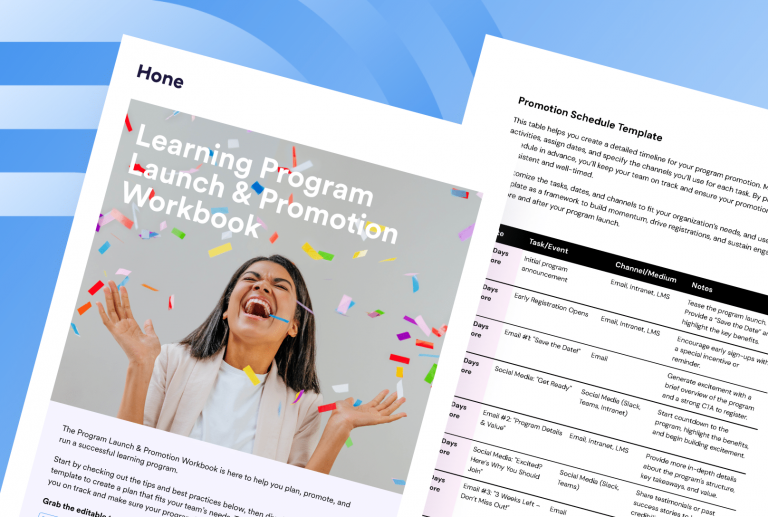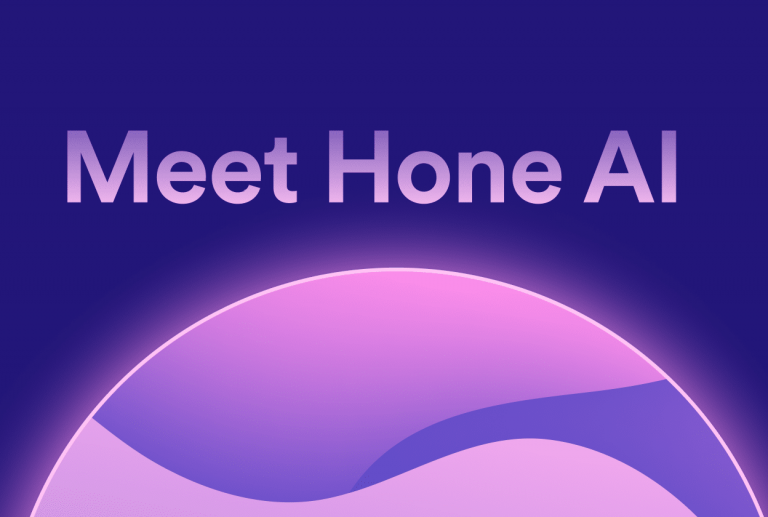What is Workforce Analytics?
The definition of workforce analytics refers to using data analysis tools to gain insights into how employees are performing and what training they might need. This involves collecting and measuring data on things like employee skills, productivity, job satisfaction, and retention rates. By analyzing this data, HR and L&D professionals can identify areas where employees may need more training or support to improve their performance. This helps them create targeted training programs that address these specific needs.
Workforce analytics can also be used to evaluate the effectiveness of training programs by tracking metrics such as completion rates, performance improvements, and employee feedback. This helps learning leaders and professionals make informed decisions about how to improve their training programs to better meet the needs of employees and the organization as a whole.
A Note on Data Privacy and Ethics
When it comes to workforce analytics, data privacy, and ethics are critical considerations that should not be overlooked. As more and more employee data is collected and analyzed, it’s important to protect individuals’ rights and privacy. Employers should be transparent about what data is being collected and how it will be used and obtain informed consent from employees before collecting personal information. Additionally, ethical considerations such as non-discrimination and fairness should be taken into account when interpreting and acting upon the data. Including a section on these important topics in your workforce analytics strategy will demonstrate a commitment to ethical and responsible data use and help build employee trust and engagement.
Why Are Workforce Analytics Important?
Workforce analytics are important because they enable HR professionals to create measurable impact through human resource (HR) processes and outcomes. Analyzing and visualizing data brings insights, connecting the dots from activities to results to organizational goals through the HR value chain. With high data literacy, HR professionals can use existing and emerging technology to drive better business outcomes by reading, writing, and communicating information in context. For example, learning leaders can identify learning success criteria, align objectives to learner application, and implement a phased evaluation approach to define evaluation cadence and evaluate data collection. Workforce analytics also have the potential to help managers improve their direct reports’ careers through more effective feedback and career pathing systems.
Workforce Analytics vs. Workplace Analytics
Workforce analytics and workplace analytics are related but different concepts.
Workforce analytics refers to the use of data to analyze and optimize workforce performance. It involves gathering data on a range of workforce metrics, such as productivity, turnover rates, employee engagement, and demographics. Workforce analytics aims to use this data to identify patterns, trends, and insights that can inform HR strategies and decision-making.
On the other hand, workplace analytics is focused on the physical workplace and how it is utilized by employees. It involves collecting data on how employees use space, such as which areas are most frequently used, when and for how long, and how people move throughout the space. Workplace analytics is used to optimize the design and layout of a workspace to improve employee satisfaction, productivity, and well-being. Workplace analytics provides objective data, so decision-makers can make calculated business choices about the workspace that:
- Are cost-effective
- Benchmark performance metrics
- Improve organizational agility and efficiency
- Manage compliance and risks
- Optimize labor costs and employee productivity
- Promote diversity, equity, and inclusion
- Reduce employee turnover
Leaders can use these critical insights to make better-quality and more timely decisions. A clear picture of how employees use the workplace helps them determine the best ways to improve the environment and optimize productivity. Data can help design or redesign the workplace to support employees’ different working needs and back up workplace projects. Likewise, it can identify gaps in the organization’s security and increase employees’ safety.
What are the Types of Workforce Analytics?
1. Employee Productivity Analytics
A business’s profitability depends, in large part, on the employees’ performance. Through employee productivity analytics, organizations can evaluate their work.
Productivity metrics mean something different to each business. Leaders need to choose a productivity measure based on the type of business operation. Some examples of workforce analytics include volume, quantity, quality, dollar value, services, etc.
Employee productivity analytics are helpful when defined and used appropriately. The best ways to measure workforce productivity:
- Establish a baseline for every position that includes the expected output.
- Identify benchmarks and objectives.
- Clearly explain the set target by tasks.
- Track individual and team progress.
In addition, employee performance tracking needs to have a timeframe. For example, managers can set the number of deliverables in a shift, week, or quarter. Deadlines are vital for measuring performance rates, especially regarding efficiency.
2. Employee Engagement Analytics
Employee engagement can be hard to quantify, but it is the commitment to an organization. Good employee engagement improves business performance.
William Kahn, a Professor at Boston University, coined and defined the term in his 1990 paper, Psychological Conditions of Personal Engagement and Disengagement at Work, as “the harnessing of organization members’ selves to their work roles; in engagement, people employ and express themselves physically, cognitively, and emotionally during role performances.”
Employee engagement analytics are usually the result of experiences and many feelings. Some examples can be the answers to the following questions:
- Are you satisfied with your current responsibilities?
- Do you believe in the organization’s mission?
- Would you consider leaving your organization for a similar role at another company?
Organizations may utilize employee engagement surveys to assess the workplace’s tone. An employee feedback analysis can help leaders recognize patterns, challenges, and problems.
Workplace satisfaction can play a big role in engagement. Employee satisfaction metrics may be a combination of the employee net promoter score (eNPS), absenteeism rate, employee satisfaction index, and turnover.
3. Diversity, Equity, and Inclusion (DEI) Analytics
Companies need to have DEI initiatives to foster creativity, fresh perspectives, and understanding. Likewise, people of different races, abilities, ages, genders, religions, sexual orientations, and other diverse backgrounds can be made more comfortable in the workplace through DEI strategies.
Diversity, equity, and inclusion metrics provide a baseline understanding of how the organization is performing in terms of compliance with regulations. An equity data analysis identifies opportunities to deepen DEI commitments and guide strategic resourcing and action-planning decisions.
Some types of diversity analytics include:
- Workforce analytics – Identifies gaps in demographic groups
- Inclusion data – Shows how different groups experience the workplace
- Performance indicators – Connects the link between inclusion and business outcomes
- Inclusion competencies – Illustrates the daily interactions of employees and the overall workplace experience by individuals
Data from diversity and inclusion reporting provides the grounds for strategies and their measurable impacts.
4. Talent Acquisition Analytics
HR analytics is a catch-all for all things that fall under human resources, including current and potential employees. Recruiting can use workforce analytics to find the right people at the right time.
HR departments can use talent acquisition analytics to strategize recruitment practices and processes. Using recruiting metrics, HR professional can:
- Review supply and demand. Headcount planning and management is the main focal point for many HR professionals. Workforce planning partially involves identifying gaps in teams and departments and locating good possible candidates.
- Exam fair and competitive compensation. Workforce metrics can analyze salaries in different positions. Businesses can also be better informed on wages and benefits from other companies in the same industry.
- Evaluate recruiting cycle. An applicant tracking analysis can review where candidates come from (sourcing), quality of hire, and onboarding delays. Similarly, data can provide a better idea of the costs per hire and the average hiring time, leading to a more efficient process.
- Post-recruiting evaluations. Talent analytics programs look at all the information and skills candidates provide in their applications and elsewhere throughout the hiring process. Analytics can pinpoint candidates’ traits and skills in high or low demand and other insights.
Analytics provide a guide to attracting and hiring diverse talent who benefit the business’s objectives. These metrics give access to impartial information on which candidates have the best talent and how to garner it.
5. Employee Retention Analytics
Employees’ performance, loyalty, and commitment to staying heavily affects organizations’ productivity and profits. And high voluntary turnover rates are detrimental to a business’s bottom line.
Employee retention analytics are essential measures of how well an organization keeps its staff over a period of time. In general, a good retention rate is above 90%.
An employee loyalty analysis looks at which aspects of the company culture employees enjoy and which they find more troublesome. Companies can then follow powerful tips to improve employee retention rates in the workplace once they know the source of the problem.
Likewise, HR professionals should also look at other types of retention metrics, such as the absence rate. High levels of absenteeism could signify problems with employee motivation and engagement.
Sometimes, retention problems can be the result of career stagnation. Workforce analytics of business processes and functions and workers’ relationships and knowledge help HR provide recommendations regarding internal mobility. Talent analytics can indicate which workers are more engaged with their roles and the business, which can increase retention rates of higher-performing employees.
6. Predictive Analytics
Sometimes predictive analytics is referred to as optimization analytics. Workforce forecasting can predict employee behavior or anticipate changes in the labor market. An organization can combine its insights to:
- See where it is now
- Identify what needs to change
- Determine how it could grow
- Find out what it could improve upon
- Pinpoint where to take action
Predictive analytics empowers companies to make data-driven decision-making in various areas, including productivity, future hiring needs, and employee retention.
For instance, companies that want to expand must examine their existing expertise and assess whether they have the requisite skills base to grow. Hiring managers can look at the future of work analysis and predict what skills they look for in new candidates.










